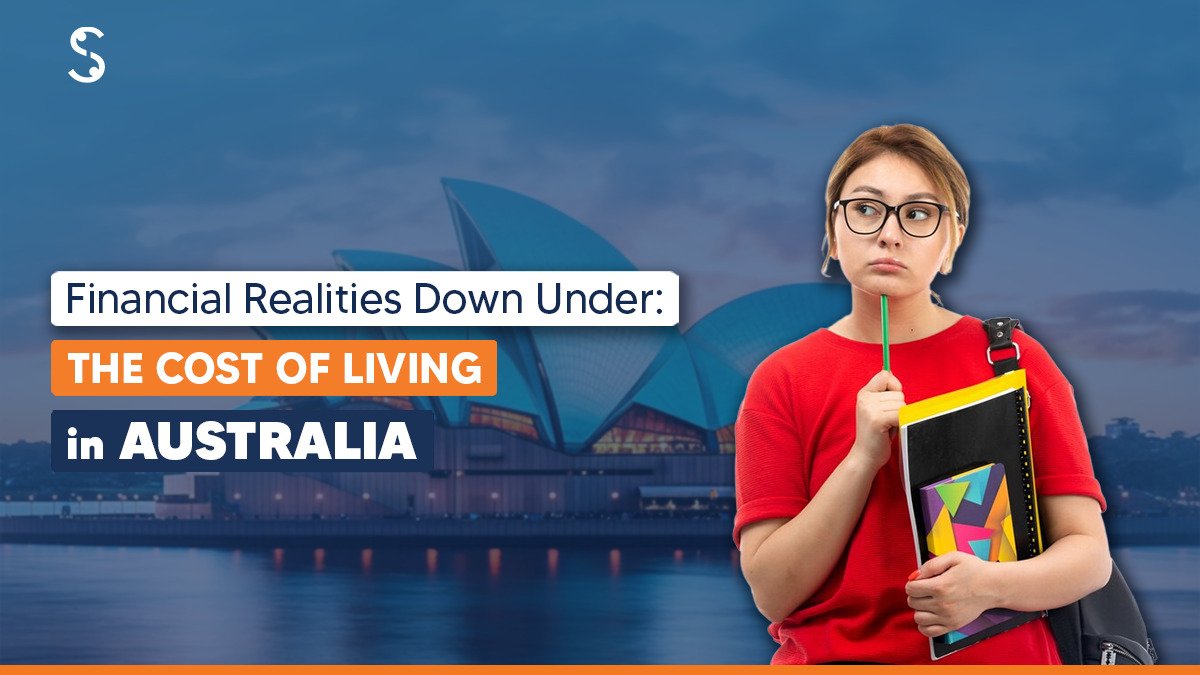
Cost of Living in Australia
If you plan to move to Australia, knowing about the Cost of Living in Australia for 2025-26 is essential. Australia is popular for its lavish lifestyle, good job opportunities, and top-quality education. This makes it a favourite destination for students and professionals worldwide.
Whether you’re considering accommodation, food, transport, or entertainment, understanding the costs can help you budget and enjoy life in Australia. With its lively cities and beautiful beaches, Australia offers a perfect mix of work, study, and fun, making it an ideal place to live.
In this guide, we’ll walk you through the living costs in Australia and share some valuable tips on how students can enjoy a budget-friendly lifestyle while studying there.
Why Do Indian Students Choose to Study in Australia?
Indian students increasingly opt for Australia as their study destination due to its high-quality education, diverse courses, and welcoming multicultural environment.
Here’s a look at the top reasons behind this growing trend.
1. World-Class Education
Australian universities are globally recognised. It ensures quality education and research opportunities.
2. Variety of Courses
A broad range of Bachelor’s and Master’s programs across various verticals. It allows flexibility in career paths.
3. Multicultural Society
A diverse and welcoming environment with students from all over the world.
4. Work Opportunities
Students can work part-time during their studies. It helps to gain experience and earn money.
5. Post-Study Visa
Opportunities to stay and work in Australia after graduation through post-study work visas.
Understanding the Cost of Living in Australia for Indian Students
For Indian students pursuing higher education in Australia, it’s essential to understand the cost of living in Australia to manage finances effectively. The estimated cost of living in Australia for an Indian or International student is AUD 2,000 – AUD 3,000 ( Approx 1 Lakh to 2.5 Lakh ) a month. This estimate contains various everyday costs crucial for a comfortable student life.
1. Daily Expenses
Daily expenses such as groceries and personal care form a significant part of your monthly budget. Food costs can vary based on dietary preferences and eating habits. Health insurance is mandatory for international students. It also contributes to your monthly expenditure.
2. Transportation
With an average monthly expense of $170* for public transit passes. However, if you prefer private transportation, such as owning a car, your costs will significantly increase due to fuel, maintenance, and parking fees.
3. Utilities
Essential utilities such as electricity, heating, cooling, water, and waste management are around $335* additional monthly expenses. Additionally, these costs can fluctuate depending on your usage. Efficient management of these utilities can help keep your costs under control.
4. Location-Based Variations
The cost of living can vary depending on the city or region in which you reside. Major cities like Sydney and Melbourne typically have higher living costs than smaller cities or rural areas.
Additionally, lifestyle choices, such as dining out frequently or engaging in social activities, can further influence your budget.
| Factors | Monthly Cost in INR* | Monthly Cost in A$* |
| Rent | INR 1.1-1.5 Lakh | A$ 2200 |
| Food & Groceries | INR 22,800 | A$ 420 |
| Transportation | INR 9,050-9,600 | A$ 190 |
| Phone and Internet Services | INR 7,500 | A$162 |
| Other Basic Utilities | INR 18,300 | A$ 365 |
Note: The figures mentioned above are subject to change.
Cost of Studying in Australia for Indian Students
Studying in Australia is generally more cost-effective than in the US. The tuition fees vary from $10800 to $35000 depending on the university, location and your chosen program. On average, the annual tuition fee for international students differs based on the level of study—whether it’s a bachelor’s, master’s, doctoral program or Diploma.
Specialised fields such as veterinary science and medicine typically have higher fees due to their extensive resources, facilities, and research programs. On the other hand, programs like computer science and accounting usually cost less due to less demand.
To help you plan your budget, we’ve provided average annual tuition fee estimates for various courses in Australia. This information will give you a clearer understanding of bachelor’s and Master’s programs. Additionally, their financial requirements assist you in making informed decisions about your educational investment.
Explore the Annual Tuition Fees in Australia:
| Course | Annual Tuition Fee in INR* | Annual Tuition Fee in A$* |
| Bachelor’s Degree | INR 12- 25 Lakh | A$20,000 – A$45,000 |
| Master’s Degree | INR 14 – INR 30 Lakh | A$22,000 – A$50,000 |
| Doctoral Degree | INR 12 – INR 24 Lakh | A$20,000 – A$42,000 |
Note: These figures are estimates and may vary based on the current exchange rate.
Top 5 Affordable Cities in Australia
Australia’s cost of living is approximately 235% higher than India’s, but it varies significantly depending on the location. While Sydney and Melbourne are among the world’s priciest cities, Hobart and Townsville are much more budget-friendly.
Australia offers diverse living experiences, but some cities are affordable for those mindful of their budget. You can enjoy a high quality of life in several locations without breaking the bank.
We will explore Australia’s top five affordable cities, highlighting their unique characteristics and why they may be the perfect choice for those looking to balance cost with lifestyle.
Explore the top 5 affordable cities in Australia to study:
| City | Monthly Cost in INR | Monthly Cost in A$ |
| Bendigo | INR 1 Lakh | A$ 1,315 |
| Wagga Wagga | INR 1.13 Lakh | A$ 1,361 |
| Bunbury | INR 1.14 Lakh | A$ 1,372 |
| Shepparton | INR 1.15 Lakh | A$ 1,391 |
| Rockhampton | INR 1.16 Lakh | A$ 1,392 |
Note: These figures are estimates and may vary depending on the specific city in Australia.
Top 5 Most Expensive Cities in Australia
Below is a list of Australia’s priciest cities, where the cost of living is notably higher. These expenses are based on average accommodation costs, food, transportation, and other utilities.
Below is a table which has a detailed breakdown of the most expensive cities in Australia:
| City | Monthly Cost in INR* | Monthly Cost in A$* |
| Sydney | INR 2.0 – 2.1 Lakh | A$ 2,623 |
| Melbourne | INR 1.97 – 2.0 Lakh | A$ 2,367 |
| Brisbane | INR 1.97 – 2.0 Lakh | A$ 2,363 |
| Perth | INR 1.93 – 2.0 Lakh | A$ 2,324 |
| Canberra | INR 1.93 – 2.0 Lakh | A$ 2,321 |
Note: The figures provided are subject to change.
Tips to Reduce Your Living Costs in Australia
Managing living costs is crucial for international students in Australia. While top universities and job opportunities are in major cities, there are several ways to reduce expenses without compromising your lifestyle.
1. Education
Public universities should be considered over private ones when utilising free learning resources and other facilities. Apply for scholarships and consider used or rental textbooks.
2. Accommodation
Using sharable/rented accommodation can save you expenses to an extent comparable to a private house.
3. Utilities
Conserve energy to lower your electricity bill. Choose cost-effective internet and mobile plans.
Transportation. Use public transport, carpool, or cycle for shorter distances. Walking is also a cost-effective option.
4. Healthcare
Utilise Medicare or public health services and opt for bulk billing. One must have health insurance to save their health care-related expenses.
5. Groceries and Meals
Cook at home, limit dining out, and plan meals to avoid impulsive purchases. Seek free or low-cost activities, such as community fairs and public events. Look for discounts on entertainment and membership.
Effective financial management involves creating a budget and reviewing your expenses monthly to identify areas for savings. Implement these tips to fit your individual needs for long-term economic stability.
How Shuraa Education Can Help
Understanding the cost of living in Australia is critical to managing your budget effectively. Australia offers great opportunities but can be pricey, so knowing what to expect for rent, food, and transport is essential.
Shuraa Education is here to guide you through these financial details. We can help you find affordable options and budget wisely for your time in Australia.
For personalised advice, contact us at +91 931 9998925 or email info@shuraaeducation.com. Let us help you make your move to Australia smoother and more affordable.
FAQs
Q1. Is Australia more expensive than the United States?
No, living costs in the U.S. are generally higher than in Australia. Australia ranks tenth in expense globally, behind countries like Luxembourg and Singapore.
Q2. Is Australia cheaper than Canada?
No, living costs in Australia are generally higher than in Canada. The average monthly cost in Australia is INR 1,07,500, while in Canada, it’s INR 97,000. Rent costs in both countries are similar, around INR 1.2-1.3 Lakhs.
Q3. What is the average rent in Australia?
Average rent in Australia ranges from INR 1.3-1.5 Lakhs in the city centre and INR 1.2-1.3 Lakhs outside the city. This is in addition to the average monthly living cost of INR 98,500, covering food, medical, and transportation expenses.
Let's Talk.
Please leave your details and we will contact you shortly!
Categories
Trending Post
Latest Post

BSc in Computer Science in UK
Pursuing a BSc in Computer Science in the UK offers Indian students an exceptional academic and career-launching experience. The United Kingdom is known for its educational excellence, advanced research, and innovative teaching methodologies, making it a global hub for computer science education. Home to pioneers such as Alan Turing and Tim Berners-Lee, the UK has […]
Read More
MBBS Abroad: Top Universities, Fees & Eligibility
Many Indian students dream of becoming doctors, but getting into a medical college in India isn’t easy. Every year, lakhs of students appear for NEET, but only a limited number of seats are available, especially in government colleges. Private colleges, on the other hand, are often too expensive for most families. That’s why more and […]
Read More
Master’s Study in Spain – A Guide for 2025
Spain is quickly becoming one of the best places to study for a master’s degree in 2025. It offers top universities, affordable fees, and a relaxed, friendly lifestyle that many students love. For Indian students, especially, Spain gives a chance to study in English, explore a new culture, and build an international career, all without […]
Read More

